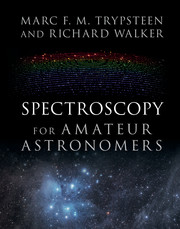
- Publisher:
- Cambridge University Press
- Online publication date:
- July 2017
- Print publication year:
- 2017
- Online ISBN:
- 9781316694435

This accessible guide presents the astrophysical concepts behind astronomical spectroscopy, covering both the theory and the practical elements of recording, processing, analysing and interpreting your spectra. It covers astronomical objects, such as stars, planets, nebulae, novae, supernovae, and events such as eclipses and comet passages. Suitable for anyone with only a little background knowledge and access to amateur-level equipment, the guide's many illustrations, sketches and figures will help you understand and practise this scientifically important and growing field of amateur astronomy, up to the level of Pro-Am collaborations. Accessible to non-academics, it benefits many groups from novices and learners in astronomy clubs, to advanced students and teachers of astrophysics. This volume is the perfect companion to the Spectral Atlas for Amateur Astronomers, which provides detailed commented spectral profiles of more than 100 astronomical objects.
'Attractively produced as a working pair, these books are the products of a lifetime of familiarity with observing the spectra of cosmic objects of all kinds, conditions and states. The Atlas is in effect a modern version of the 1943 MKK Atlas, at one time a centrepiece of almost all student astronomy studies and courses. … An important development on the 1943 MKK Atlas is the addition of displays as graphs as well as images, and detailed labelling of the wavelengths of critical features. … The supporting volume Spectroscopy for Amateur Astronomers, is … a collection of notes on various aspects of both practical and theoretical spectroscopy - almost a ‘guide’ to the cosmos - and on recording and analysing what one can observe. A substantial list of references, plus tables of star names, a magnitude scale, and similar packets of useful information for the sky-watcher, are also included.'
Elizabeth Griffin Source: The Observatory
'… most professional astronomers using optical telescopes devote the majority of their observing time to spectroscopy rather than imaging. The reason is simple: spectroscopic data provide far more information about an astronomical object than an image, such as its velocity, temperature, chemical composition, and magnetic field strength. In this volume, [the authors] present a hands-on guide to spectroscopy - one that equips amateur astronomers with both the theoretical and the technical knowledge necessary to progress from imaging to spectroscopy. The text first covers the basic physics behind spectral lines formation at a level appropriate for sophomore-level atomic physics courses, using mainly high school geometry and algebra … Next follows the heart of the book, which provides readers with a guide to the optical designs of various types of spectrometers, including … information on commercially available units. Finally, the text discusses the many research opportunities open to amateurs with a small telescope and spectrometer …'
R. L. Mutel Source: Choice
'Cambridge University Press boasts a strong line of books on astronomy, and with the recent release of two books on amateur spectroscopy, the collection has grown only stronger. … If you’re looking for a new observing challenge, or know someone who is, look to CUP for help getting started in with spectroscopy. … If you’re a motivated amateur, this book will help you choose a spectrograph, guide you through your first recording, offer advice on processing the recorded spectra, and show you how to analyze it - all with amateur equipment. Pair this book with Richard Walker’s Spectral Atlas for Amateur Astronomers and you’ll have a comprehensive package on spectroscopy.'
S. N. Johnson-Roehr Source: Sky & Telescope: The Essential Guide to Astronomy
This atlas is supported by the present book to provide basic information, definitions and formulas.
The following publications and presentations are from various internet sources. The web addresses may change or expire with time. The corresponding PDF or html files should readily be found using a search engine, by entering of title and author.
 Loading metrics...
Loading metrics...
* Views captured on Cambridge Core between #date#. This data will be updated every 24 hours.
Usage data cannot currently be displayed.